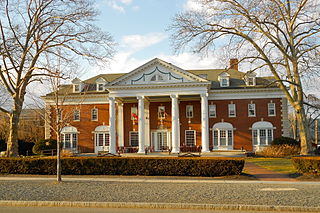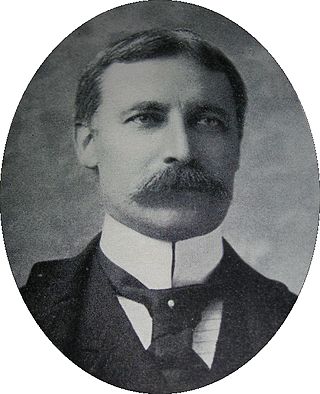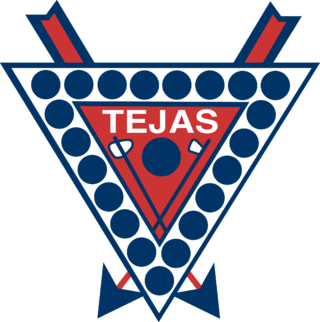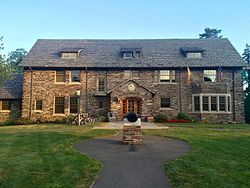
Princeton University is a private Ivy League research university in Princeton, New Jersey. Founded in 1746 in Elizabeth as the College of New Jersey, Princeton is the fourth-oldest institution of higher education in the United States and one of the nine colonial colleges chartered before the American Revolution. The institution moved to Newark in 1747, and then to its current campus, nine years later. It officially became a university in 1896 and was subsequently renamed Princeton University.

The Princeton School of Public and International Affairs is a professional public policy school at Princeton University. The school provides an array of comprehensive coursework in the fields of international development, foreign policy, science and technology, and economics and finance through its undergraduate (AB) degrees, graduate Master of Public Affairs (MPA), Master of Public Policy (MPP), and PhD degrees.

Campus Club was one of the undergraduate eating clubs at Princeton University. Located on the corner of Washington Road and Prospect Avenue, Campus was founded in 1900. It was one of the eating clubs that abandoned the selective bicker process to choose members non-selectively, a status it held for over twenty years.

The Princeton Quadrangle Club, often abbreviated to "Quad", is one of the eleven eating clubs at Princeton University that remain open. Located at 33 Prospect Avenue, the club is currently "sign-in," meaning it permits any second semester sophomore, junior or senior to join. The club's tradition of openness is demonstrated as far back as 1970, when Quadrangle became one of the first coeducational eating clubs.

Norman Ralph "Norm" Augustine is a U.S. aerospace businessman who served as United States Under Secretary of the Army from 1975 to 1977. Augustine served as chairman and CEO of the Lockheed Martin Corporation. He was chairman of the Review of United States Human Space Flight Plans Committee.

Colonial Club is one of the eleven current eating clubs of Princeton University in Princeton, New Jersey, United States. Founded in 1891, it is the fifth oldest of the clubs. It is located on 40 Prospect Avenue.

The Ivy Club, often simply Ivy, is the oldest eating club at Princeton University. It was founded in 1879 with Arthur Hawley Scribner as its first head.

The Princeton Reunions are an annual college reunion event held every year on the weekend before commencement at Princeton University. Known simply as "Reunions", this event brings back to campus upwards of 25,000 alumni and guests for a four-day celebration featuring large outdoor tents, elaborate costumes, sporting events, alumni and faculty presentations, fireworks, and bands from rock to swing.

Princeton Tower Club is one of the eleven eating clubs at Princeton University in Princeton, New Jersey, United States, and one of seven clubs to choose its members through a selective process called bicker. Tower is located at 13 Prospect Avenue between the university-run Campus Club and the Cannon Club; it currently has a membership of approximately 215.

The Princeton Charter Club is one of Princeton University's eleven active undergraduate eating clubs located on or near Prospect Avenue in Princeton, New Jersey, United States.

Tiger Inn is one of the eleven active eating clubs at Princeton University in Princeton, New Jersey. Tiger Inn was founded in 1890 and is one of the "Big Four" eating clubs at Princeton, the four oldest and most prestigious on campus. Tiger Inn is the third oldest Princeton Eating Club. Its historic clubhouse is located at 48 Prospect Avenue, Princeton, New Jersey, near the Princeton University campus. Members of "T.I." also frequently refer to the club as "The Glorious Tiger Inn."

Princeton Terrace Club is one of eleven current eating clubs at Princeton University in Princeton, New Jersey, United States. Terrace Club was founded in 1904 and is located at 62 Washington Road. It is the sole Princeton eating club located off Prospect Avenue.

Moses Taylor Pyne, was an American financier and philanthropist, and one of Princeton University's greatest benefactors and its most influential trustee.

Cap and Gown Club, founded in 1890, is an eating club at Princeton University, in Princeton, New Jersey, United States. Colloquially known as "Cap", the club is one of the "Big Four" eating clubs at Princeton. Members are selected through a selective process called bicker. Sometimes known as "the Illustrious Cap and Gown Club," it was the first of the currently selective eating clubs to accept women. Though personalities of eating clubs certainly change throughout the years, Cap and Gown is described in F. Scott Fitzgerald's This Side of Paradise as "anti-alcoholic, faintly religious and politically powerful."

The University Cottage Club or simply Cottage Club is one of eleven current eating clubs at Princeton University, in Princeton, New Jersey, United States. It is one of the six bicker clubs, along with The Ivy Club, Tiger Inn, Cap and Gown Club, Cannon Club and Tower Club.

The Texas Cowboys is an honorary student service organization at the University of Texas. The organization was founded in 1922 with the purpose of serving the University of Texas and maintaining Smokey the Cannon. It is considered one of the "oldest and most elite student organizations" at the university. The Texas Cowboys serve as the highest caliber ambassadors to the University of Texas. Among its alumni are national politicians, two Texas Governors, prominent businessman, and professional athletes.

The eating clubs at Princeton University are private institutions resembling both dining halls and social houses, where the majority of Princeton undergraduate upperclassmen eat their meals. Each eating club occupies a large mansion on Prospect Avenue, one of the main roads that runs through the Princeton campus, with the exception of Terrace Club which is just around the corner on Washington Road. This area is known to students colloquially as "The Street". Princeton's eating clubs are the primary setting in F. Scott Fitzgerald's 1920 debut novel, This Side of Paradise, and the clubs appeared prominently in the 2004 novel The Rule of Four.

Cloister Inn is one of the undergraduate eating clubs at Princeton University in Princeton, New Jersey, United States.

Prospect House, known also as just Prospect, is a historic house on the Princeton University campus in Princeton, Mercer County, New Jersey, United States. Built in 1851, it is a fine example of the work of architect John Notman who helped popularize Italianate architecture in America. Notable residents include Woodrow Wilson during his tenure as president of the university. The building now serves as a faculty club. It was designated a National Historic Landmark in 1985 for its architecture and historic associations.

The Tejas Club is one of the oldest student organizations at the University of Texas at Austin. It was founded in 1925, and only has male members. The official purpose of the club is "to allow our members to live a more complete life by sharing their personalities, abilities and efforts to promote good fellowship and a high standard of conduct among ourselves and our fellow students, to encourage loyalty and usefulness to our school, and to further good scholarship." The membership process of the organization is secretive and not open to the public.
























